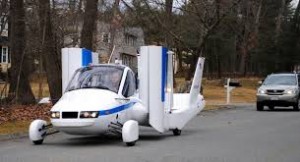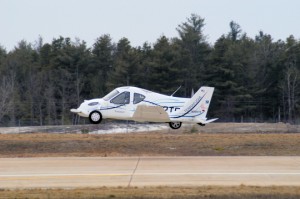I am a cyclist myself. I don’t have a car here in the USA, although I do have one sitting on the drive in Italy. The problem with cars is not only that they pollute but also getting stuck in traffic.
When I go out on my bike I know exactly how long it will take me to do my trip, presuming that I have done it before. So I can get to my music lessons in 25 minutes, or to the dentist in 20. If I take a car though sometimes it takes 10 minutes, but sometimes it takes half an hour or more, so I have to leave with ample time to adjust for these problems.
Oh and a million people a year are killed in cars, although biking is certainly no safer. What we need is an alternative, and today for you ladies and gentlemen (and third Gendered) I have started saving up for my answer and dream, a flying car.
No longer the stuff of dreams, local Massachusetts company Terrafuggia are now taking orders for their series of flying cars that will be launched in 2015.
A prototype exists already, and in this CNN video we can see the CEO driving it to the gas station, filling up and taking it for a fly. At a little over $275 000 it may not be in everybody’s price range, but could this seriously change the way we move around in the near future?
I think the USA is the perfect place for such a machine as there are plenty of open spaces for take off and landing, but I can’t see them selling many in Hong Kong or Singapore, or even my home city of Manchester to be honest.
But returning to the craft itself the spec is interesting. As the website states “the Transition® is the transportation of the future today. A street-legal airplane that converts between flying and driving modes in under a minute, the Transition® brings a new level of freedom, flexibility, and fun to personal aviation. It gives the pilot the option to land and drive in bad weather, provides integrated ground transportation on both ends of the flight, and fits in a standard single car garage at home. The Transition® can fly in and out of over 5,000 public airports in the U.S. and is legal to drive on public roads and highways. It is the only light aircraft designed to meet Federal Motor Vehicle Safety Standards, and it is also equipped with a full-vehicle parachute for additional safety”
It can fly 500 miles on a single tank of gas, travels at 100 mph, has automated landing capability, is equipped with a parachute in case of emergencies and you can learn to fly it in less than a day.
The company is also working on an electric vertical take off craft, but this is still in the design stage.
I like the idea, what do you think? No more ice cream for the kids, health club for the wife or golf for me and I reckon that by the time I’m 60 I could buy a second hand one.




